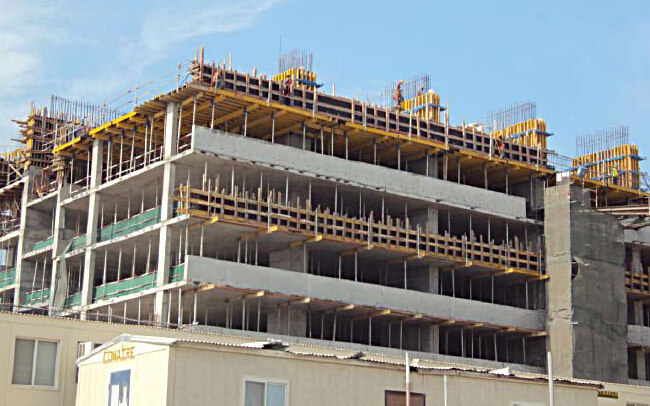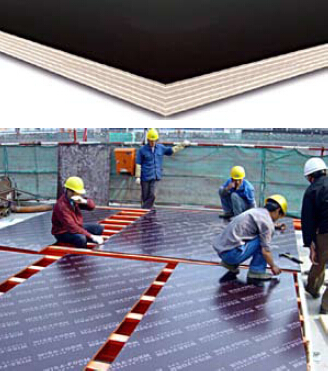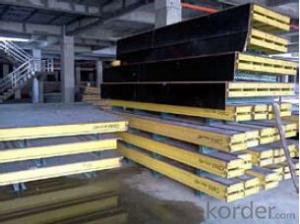Plywood-Formwork System for formwork and scaffolding
- Loading Port:
- Tianjin
- Payment Terms:
- TT OR LC
- Min Order Qty:
- 50 m²
- Supply Capability:
- 1000 m²/month
OKorder Service Pledge
Quality Product, Order Online Tracking, Timely Delivery
OKorder Financial Service
Credit Rating, Credit Services, Credit Purchasing
You Might Also Like
Plywood --- make perfect concrete surface
WISA-Form Birch is a coated special plywood using in the formwork systems where high
requirements are set on the concrete surface and the times of reuses.
With CNBM timber beam & WISA plywood, the formwork is low weight but high load capacity, it is
widely used in construction.
Characteristics:
◆ Component with high standardization.
◆ Assembling in site, flexible application.
◆ Light weight, easy transportation and storage.


- Q:Does steel formwork require any special maintenance?
- Yes, steel formwork does require regular maintenance. This includes cleaning and removing any residual concrete, inspecting for damages or defects, and applying protective coatings to prevent corrosion. Regular maintenance ensures the longevity and effectiveness of steel formwork in construction projects.
- Q:Can steel formwork be used in retail or commercial construction projects?
- Yes, steel formwork can be used in retail or commercial construction projects. Steel formwork is a versatile and durable solution for creating concrete structures in construction projects. It offers several advantages such as high reusability, excellent dimensional stability, and the ability to handle high concrete pressures. In retail or commercial construction projects, steel formwork can be used for various applications such as constructing columns, walls, beams, slabs, and staircases. It provides a sturdy framework that ensures accurate and smooth concrete placement, resulting in high-quality finishes. Additionally, steel formwork can be easily customized and adjusted to suit different project requirements, making it suitable for projects with complex architectural designs. Furthermore, steel formwork offers significant time and cost savings in construction projects. Its reusability reduces the need for frequent formwork replacements, resulting in reduced material and labor costs. The use of steel formwork also enhances construction efficiency, as it allows for faster assembly, disassembly, and repositioning of formwork components. Overall, steel formwork is a reliable and efficient choice for retail or commercial construction projects, providing the necessary strength and flexibility required for such applications.
- Q:How does steel formwork affect the overall thermal performance of the structure?
- Steel formwork does not significantly affect the overall thermal performance of a structure as steel is a good conductor of heat. However, it can indirectly impact thermal performance by providing a solid structure that helps in maintaining insulation materials in place, thereby improving the overall energy efficiency of the building.
- Q:What are the safety precautions when working with steel formwork?
- To ensure the safety of workers when using steel formwork, it is important to adhere to specific safety measures. These measures encompass the following: 1. Comprehensive training: All workers must undergo thorough training on the proper usage of steel formwork. This entails understanding how to assemble, disassemble, and handle the formwork system. Additionally, workers should be trained to identify any potential risks or hazards associated with steel formwork. 2. Utilization of Personal Protective Equipment (PPE): Workers should consistently wear appropriate PPE, which typically consists of safety helmets, steel-toed boots, high-visibility vests, and gloves. Depending on the tasks involved, additional PPE such as safety glasses or respiratory protection may be necessary. 3. Secure and stable installation: Prior to commencing work, it is crucial to securely and stably install the steel formwork. This involves proper anchoring and bracing to prevent any movement or collapse during use. Regular checks should be conducted to ensure the formwork remains stable throughout the project. 4. Safe access and egress: Workers must have safe and unobstructed access to the steel formwork. This may require the installation of secure ladders, platforms, or scaffolding to provide a stable means of reaching the formwork. Adequate lighting should also be provided to enhance visibility and prevent accidents. 5. Regular inspections: Regular inspections of the steel formwork should be carried out to identify and address any signs of wear, damage, or deterioration. This includes checking for bent or damaged components, loose connections, or signs of corrosion. Prompt action should be taken to rectify any issues and maintain the integrity and safety of the formwork. 6. Proper lifting and handling techniques: When moving or lifting steel formwork components, workers should employ appropriate lifting techniques and equipment. This may involve the use of cranes, hoists, or forklifts, depending on the size and weight of the components. Adequate training and supervision should be provided to ensure adherence to safe lifting practices. 7. Effective communication: Clear communication among workers is paramount when working with steel formwork. This can be achieved through the use of hand signals, radios, or other communication devices to relay important information or warnings. Additionally, clear signage and barriers should be employed to indicate restricted areas or potential hazards. By adhering to these safety precautions when working with steel formwork, the risk of accidents, injuries, or structural failures can be significantly minimized, resulting in a safer working environment for all individuals involved.
- Q:Is steel formwork suitable for projects with limited access?
- Yes, steel formwork can be suitable for projects with limited access. Steel formwork is known for its high strength and durability, allowing it to withstand the challenges of a project with limited access. It can be easily transported and assembled in confined spaces, making it a favorable choice for projects where access is restricted. Additionally, steel formwork can be easily dismantled and reused, which is beneficial in limited access situations where materials need to be transported in and out efficiently. The flexibility and adaptability of steel formwork make it a viable option for projects with restricted access.
- Q:Can steel formwork be used for both temporary and permanent structures?
- Yes, steel formwork can be used for both temporary and permanent structures. Steel formwork is a versatile and durable construction material that can withstand high pressures, making it suitable for various types of structures. For temporary structures, such as construction sites or temporary shelters, steel formwork provides a quick and efficient solution as it can be easily assembled and disassembled. It is also ideal for permanent structures like bridges, high-rise buildings, or industrial facilities, where its strength and durability are essential. Additionally, steel formwork offers the advantage of being reusable, which makes it a cost-effective option for both temporary and permanent construction projects.
- Q:How does steel formwork handle concrete surface finishing?
- Steel formwork is a popular choice in the construction industry due to its durability, strength, and versatility. When it comes to concrete surface finishing, steel formwork offers several advantages. Firstly, steel formwork provides a smooth and even surface, resulting in a high-quality finish. The rigid nature of steel helps prevent any warping or bending during the pouring and curing process, ensuring that the concrete maintains its desired shape and dimensions. This is particularly important for achieving a level and flat surface, which is essential for many construction applications. Additionally, steel formwork allows for precise control over the concrete pouring process. The tight joints and strong connections in steel formwork prevent any leakage or seepage of the concrete, resulting in a clean and consistent surface finish. This is especially beneficial when working on projects that require a high degree of precision or have specific architectural requirements. Furthermore, steel formwork can be easily customized to create various surface finishes. By incorporating different textures, patterns, or coatings onto the steel panels, contractors can achieve a wide range of aesthetic effects on the concrete surface. This flexibility allows for creativity in design and enhances the overall visual appeal of the finished structure. Lastly, steel formwork is reusable, making it a cost-effective solution for concrete surface finishing. Unlike other types of formwork, such as wood or plastic, steel formwork can be cleaned, repaired, and reused multiple times, reducing material waste and saving on construction costs. This sustainability aspect is becoming increasingly important in the construction industry, as it contributes to a more environmentally friendly and economically viable approach. In conclusion, steel formwork provides excellent support for concrete surface finishing. Its strength, precision, customization options, and reusability make it a preferred choice for achieving high-quality finishes in construction projects. Whether it is a smooth and level surface or an intricately textured design, steel formwork ensures that the concrete surface is finished to the desired specifications.
- Q:Can steel formwork be recycled?
- Yes, steel formwork can be recycled. Steel is a highly recyclable material, and it can be melted down and reused to create new steel products. This makes steel formwork a sustainable and environmentally friendly choice in construction projects.
- Q:What is steel formwork?
- Steel formwork is a type of temporary mold or structure that is used in construction to shape and support concrete until it sets and hardens. It is made of steel sheets or plates that are welded together to create a framework. This framework is then used to hold the concrete in place while it is poured and compacted. Steel formwork is known for its durability, strength, and ability to withstand the pressure exerted by wet concrete. It is commonly used in large-scale construction projects, such as high-rise buildings, bridges, and tunnels, where the concrete needs to be shaped into complex and precise forms. Steel formwork can be easily assembled and disassembled, making it reusable and cost-effective. It also provides a smooth and uniform finish to the concrete surface, resulting in a high-quality end product. Overall, steel formwork is an essential tool in modern construction that helps in the efficient and effective construction of concrete structures.
- Q:What are the different types of accessories available for steel formwork?
- Steel formwork offers a range of accessories designed to improve the efficiency and effectiveness of the system. Several common types of accessories include: 1. Clamps - These securely connect formwork panels, providing stability and preventing movement during concrete pouring. 2. Wedges - These level and align the panels by inserting them between the panels and tightening for a secure fit. 3. Ties - Made of steel, these secure formwork panels to the structure by inserting them through panel holes and anchoring them. 4. Connectors - These join panels at corners or junctions, maintaining the formwork system's structural integrity. 5. Spacers - These maintain a specific distance between panels, ensuring the desired concrete thickness. 6. Brackets - These support formwork panels during construction, preventing sagging or bending. 7. Release agents - Applied to panels before pouring concrete, these prevent adhesion, allowing for easy removal once the concrete sets. 8. Handles - These facilitate handling and positioning of panels, providing a secure grip for proper placement. 9. Chamfers - These create beveled edges on concrete, attached to panels for a finished look. 10. Accessories for special applications - Specialized accessories exist for curved structures, columns, and beams. These examples highlight the range of accessories available for steel formwork. The choice of accessories depends on project requirements and desired outcomes. Selecting the appropriate accessories is crucial for a successful and efficient formwork system.
1. Manufacturer Overview |
|
|---|---|
| Location | |
| Year Established | |
| Annual Output Value | |
| Main Markets | |
| Company Certifications | |
2. Manufacturer Certificates |
|
|---|---|
| a) Certification Name | |
| Range | |
| Reference | |
| Validity Period | |
3. Manufacturer Capability |
|
|---|---|
| a)Trade Capacity | |
| Nearest Port | |
| Export Percentage | |
| No.of Employees in Trade Department | |
| Language Spoken: | |
| b)Factory Information | |
| Factory Size: | |
| No. of Production Lines | |
| Contract Manufacturing | |
| Product Price Range | |
Send your message to us
Plywood-Formwork System for formwork and scaffolding
- Loading Port:
- Tianjin
- Payment Terms:
- TT OR LC
- Min Order Qty:
- 50 m²
- Supply Capability:
- 1000 m²/month
OKorder Service Pledge
Quality Product, Order Online Tracking, Timely Delivery
OKorder Financial Service
Credit Rating, Credit Services, Credit Purchasing
Similar products
New products
Hot products
Related keywords























